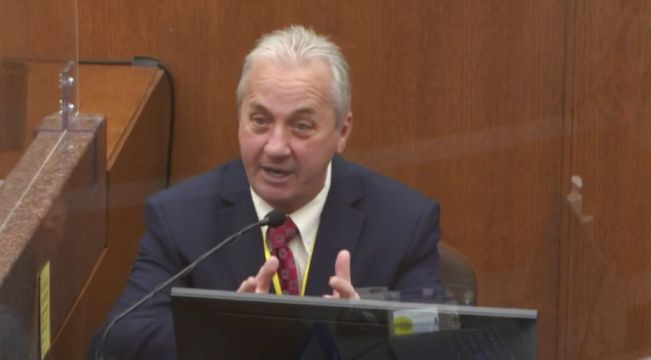Kneeling on George Floyd’s neck while he was handcuffed and in the prone position was “top-tier, deadly force” and “totally unnecessary”, the head of the Minneapolis Police Department’s homicide division testified on Friday.
“If your knee is on a person’s neck, that can kill him,” said Lieutenant Richard Zimmerman, adding that when a person is handcuffed in the prone position, “your muscles are pulling back … and if you’re laying on your chest, that’s constricting your breathing even more”.
Mr Zimmerman also testified at Derek Chauvin’s murder trial that once Mr Floyd was handcuffed, he saw “no reason for why the officers felt they were in danger, if that’s what they felt, and that’s what they would have to feel to be able to use that kind of force”.
“So in your opinion, should that restraint have stopped once he was handcuffed and thrown on the ground?” Prosecutor Matthew Frank asked.
“Absolutely,” Mr Zimmerman replied.

He also testified that officers have a duty to provide care for a person in distress, even if an ambulance has already been called.
Under cross examination, Chauvin lawyer Eric Nelson peppered Mr Zimmerman with questions about use of force, pointing out that officers must consider the entire situation when deciding about whether to use force — including what is happening with a suspect, whether the suspect is under the influence, and other surrounding hazards, such as a crowd.
Mr Zimmerman agreed with Mr Nelson that a person who is handcuffed can still pose a threat and can continue to thrash around.
His testimony came a day after a Minneapolis police supervisory sergeant who was on duty the night Mr Floyd died testified that he believes the officers restrained him for too long.
David Pleoger testified on Thursday that officers are trained to roll people on their side to help with their breathing after they have been restrained in the prone position. He said the officers could have ended their restraint of Mr Floyd after he stopped resisting.
Chauvin, 45, is charged with murder and manslaughter, accused of killing Mr Floyd by kneeling on the 46-year-old black man’s neck for nine minutes, 29 seconds as he lay face down in handcuffs last May in Minneapolis.
Mr Floyd had been accused of passing a counterfeit 20-dollar note at a neighbourhood market.
The most serious charge against the now-fired white officer carries up to 40 years in prison.

On Friday, Minneapolis Police Sergeant Jon Edwards, the overnight supervisor the night Mr Floyd died, said he secured the scene at the request of Mr Pleoger, who was still at the hospital with Mr Floyd.
Mr Edwards said Mr Pleoger told him the encounter had the potential to become a “critical incident”, which could mean someone died or was seriously injured.
The defence has argued that Chauvin did what he was trained to do when he encountered Mr Floyd last May and that Mr Floyd’s death was caused not by the knee on his neck, as prosecutors contend, but by drugs, his underlying health conditions and adrenaline.
An autopsy found fentanyl and methamphetamine in his system.
On Thursday, two paramedics who arrived on the scene that day said they saw no signs that Mr Floyd was breathing or moving.
One of them, Derek Smith, testified that he checked for a pulse and could not detect one: “In layman’s terms? I thought he was dead.”







